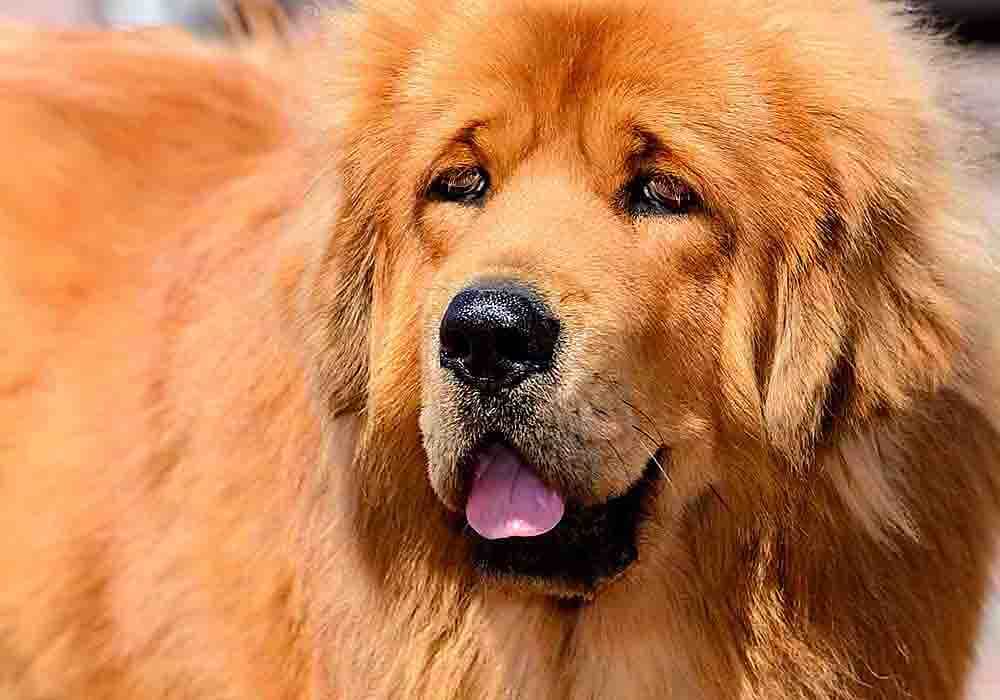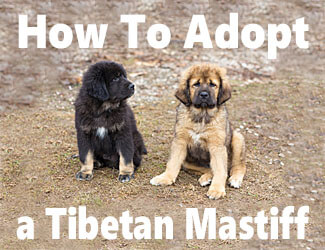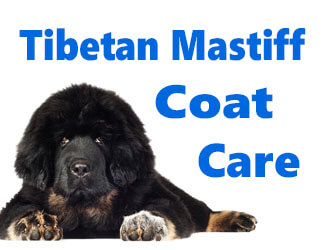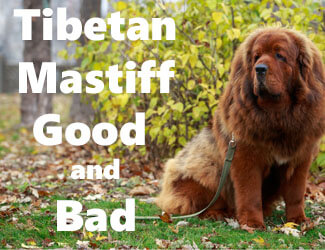Tibetan Mastiff Dog Breed
History, Temperament, Health Issues, Care
by Ken Alden
Are you considering adding a
Tibetan Mastiff as a member of your family, but don’t know too much about the
breed? You’re in luck -- this article will help you entirely understand the this dog breed.
What Is A Tibetan Mastiff Typically Like?
Tibetan Mastiffs are incredibly loyal, intelligent, protective, stubborn, and challenging. They will protect your family and your home, but they are not suited for every type of family, such as ones with young children whom they might harm because of their large size.
We know -- that’s a lot of different adjectives to describe a dog. But as you will see throughout this article, each one describes this breed perfectly. To learn more about their history, personality, and how to care for them, keep reading!
Pro-tip: Ever try lifting a Tibetan Mastiff? Their weight can hurt not only your back but their joints when they hop down from cars, sofas or even your bed. To protect your back and theirs check out the best Mastiff ramps on Amazon.com now.
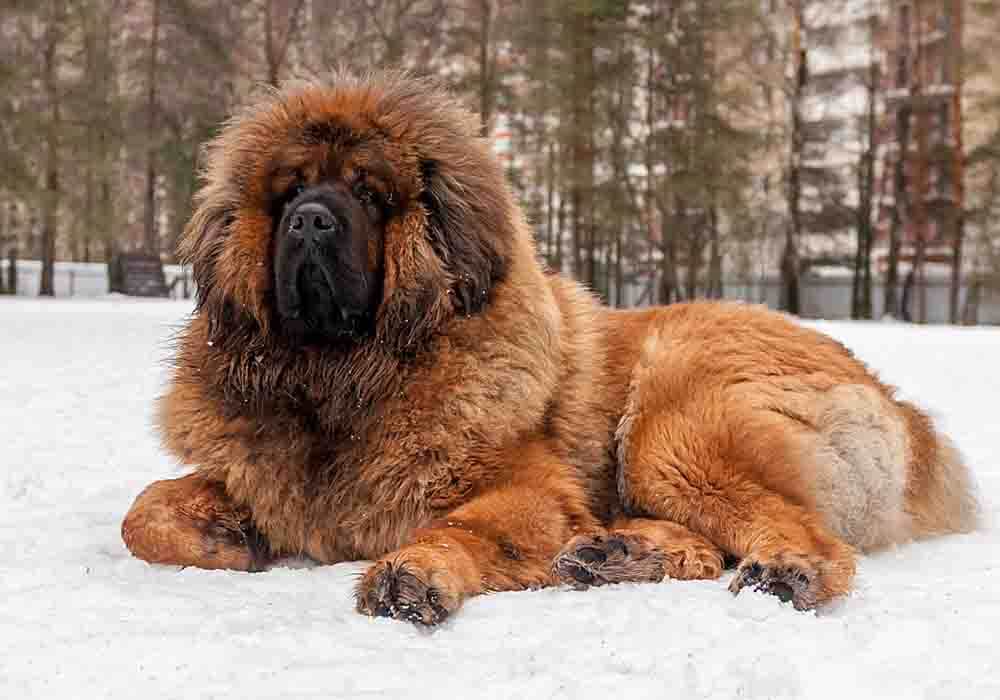
History Of The Tibetan Mastiff
As you can most likely tell by the breed’s name, Tibetan Mastiffs originated in Tibet. However, there is very little documented history on them before the late 19th century. Still, they are believed to have been around for multiple centuries.
From DNA evidence, we can say with confidence that mastiff-type dogs originated in Tibet about 5,000 years ago. There is very little doubt that the Tibetan Mastiff descended from these dogs.
These mastiff-type dogs developed
into two types. One was the Do-Khyi, who traveled with nomadic shepherds, lived
in villages, and functioned as flock guardians. The other type that was
developed was the Tsang-Khyi, which were usually given to lamaseries, serving
as guardians for lamas, or Tibetan Buddhist monks, living there.
Timeline...
● 1800: Captain
Samuel Turner mentioned a specific type of dog in his memoir. However, there was no description of
the dogs given.
● 1847: The
first Tibetan dog was brought to England. It was given to Queen Victoria. This
was a gift from Lord Hardinge, who was the Viceroy of India.
● 1873:
England’s Kennel Club was formed. The Tibetan Mastiff was officially named this in the Stud Book. This did away with its earlier title, the
“large dog from Tibet.”
● 1874: The
Prince of Wales (later, King Edward VII) imported two additional Tibetan
Mastiffs to England.
● 1875: Both
Tibetan Mastiffs were shown at the Alexandra Palace Show.
● This breed continued to be imported into England and Europe occasionally.
● 1931: It's first breed club was formed.
● WWII put an
end to the breeding of this dog.
● The Late
1950s: Nepal gifted two Tibetan Mastiffs to the President of the United States,
Dwight D. Eisenhower.
● Those two dogs were taken to a farm and vanished from the public eye.
● 1970: Several
more Tibetan Mastiffs began to be imported into the US. They became the
foundation dogs of the US line of this breed.
● 1974: The
Tibetan Mastiff Club of America was founded.
● 1974: The
American Tibetan Mastiff Association was founded.
● 1976: English
breeders began importing them again.
● 1979:
Tibetan Mastiffs appeared in first show -- the first National Specialty
Match.
● 2007:
This breed became recognized by the American Kennel Club as a member of
the Working Group.
● Today: In
Tibet, it’s currently challenging to find a purebred Tibetan Mastiff. You can
occasionally find one traveling with traders and caravans, or guarding homes
and livestock.
Tibetan Mastiff Size And Weight
This dog is quite a giant breed. They typically weigh up to 160 pounds -- but some are even heavier than that! To date, the largest of these dogs was recorded to be 250 pounds.
Males are typically between 26 and 30 inches tall when measured from the shoulder. Females are typically between 24 and 28 inches tall.
As for weight, males usually weigh between 90 and 160 pounds. Females typically range between 70 and 120 pounds.
Tibetan Mastiff Personality Traits
This dog is known to be independent, stubborn, intelligent, and (at times) challenging.
They have a strong sense of themselves and will be expected to be treated as an equal rather than a pet. They want to please the people around them, but often seek their own agenda, and need to be reminded often of what they were asked to do.
Tibetan Mastiffs are incredibly
loyal and will be a family guardian. They take their job seriously and will
typically be territorial around strangers. Early socialization can help combat
this, such as enrolling them in a “puppy kindergarten,” inviting visitors over
frequently, and taking him or her to busy areas, like the park or pet-friendly
stores.

Still curious? We wrote a whole article about Tibetan Mastiff traits, qualities and characteristics here
Pro-tip: Tibetan Mastiff anxiety, aggression, destructive chewing, jumping up, fearfulness, and other behaviors can be controlled with the right training program.
Here’s a great course that addresses these issues along with many other dog training basics: Check it out now!
Tibetan Mastiffs...The Good
Tibetan Mastiffs are quite a noble breed. They have gorgeous colors, a beautiful tail, and a long coat. They are certainly going to create conversations while you have your mastiff out and about with you.
There are so many characteristics to love about this dog breed. They are incredibly gentle, patient, understanding, and loving. The breed has been working with humans for centuries, so they are incredibly sophisticated in terms of understanding people.
They are also incredibly protective of their families. Because of this, in addition to their large size, they also make for wonderful guard dogs. They are also incredibly loyal, fearless, and hard-working.
From centuries of breeding
specifically for the task of guarding, they are an ideal protector. However,
you need to weigh these positives with some potential negatives. This dog will not be the right breed for every dog owner -- they require a
particular type of person.

This breed has so many pros and cons (mostly pros) that we've dedicated a whole article to the subject.
Tibetan Mastiffs...The Bad
While you may fall in love with your cute, cuddly teddy bear Tibetan puppy, don’t forget that he or she will grow into an adult dog that could be up to 160 pounds! Because of this, they are certainly not suited to live in an apartment.
Additionally, they are most active in the mornings and evenings. If your schedule won’t be able to accommodate exercising them during those times, then they probably are not the right dog for you.
Although one of their most positive characteristics is the fact that they are excellent protectors, they are also incredibly independent. This means that they won’t always look to you for guidance. Although they will enjoy being around you and will bond with you, they will not always obey you. This is especially true when they believe that they are right, which is why they are often referred to as being stubborn.
Because they are stubborn, they likely won’t do very well in obedience classes or agility competitions, as noted in official breed information from the American Kennel Club, which can be found here.
However, some Tibetan Mastiffs may surprise you and will do well in obedience classes. If anything, obedience training will help them become more socialized and have a higher level of respect toward you.
Additionally, although this dog is typically quiet while they are inside, they are heavy barkers if they are left outside at night. They are letting you know that they are doing their job, but this will disrupt the neighbors -- we don’t advise you to let this breed outside overnight.
Along the same lines, if you let your dog out in the yard, you should make sure that your yard is well fenced-in. This breed is known to climb fences to escape the yard. They also should not be left alone outside for too long -- they will start to dig and could become aggressive and territorial.
Additionally, you should never walk your dog off of a leash. They should also be taken on various routes throughout your daily walk so that they do not become territorial of one walking route.
Additionally, they are generally tolerant of children who are in their own household, especially if they were raised with them. However, they are generally not suited well to homes with young children.
Tibetan Mastiffs often confuse screaming, yelling, and playing of young children as a sign of aggression. So, if you have children who want to have friends over, you need to be wary of this. Socializing your dog at a young age may help with this, but they still may become territorial and see screaming and yelling as signs of aggression toward your children. They simply want to protect them.
If you are incredibly social and often have people coming and going from the house, then this breed may not be the right one for you. Because of their territorial nature, they will try to limit the number of people who enter the house.
Again, to combat this, socialize your dog from a young age. Take them to dog-friendly parks, stores, and events. Let your dog meet new people.
However, this dog is highly attuned to danger. If they have an initial dislike of someone you have met for the first time and just won’t get over it, then you should proceed with caution.
As you can see, there are many factors to keep in mind when it comes to this dog. They are a wonderful breed, but only suitable for specific types of owners and homes. They can’t just fit into any old lifestyle.
If you are interested in this breed, be sure to do thorough research and discuss your
thoughts and concerns with Tibetan Mastiff breeders and owners. If you end up
with one, you will undoubtedly have an exciting lifestyle with your new loyal
companion!

The temperament and charateristics of this breed was worthy of it's own article which we think you'll find of interest here.
Grooming Your Tibetan Mastiff
Their Coats
These dogs have incredibly thick coats -- all over their bodies. They have a double coat -- the undercoat is soft, heavy, and wooly, while the topcoat is thick, long, and has a coarse texture. However, their undercoat is significantly thinner during the warmer months of the year.
As for their hair itself? It is straight and hard -- it will never be wavy, silky, or curly.
Additionally, they have a heavy mane that covers their neck and shoulders, while their tails and upper thigh area have feathering and a heavy coat.
What about their coloring? their coats come in brown, black, blue, and gold. They may or may not have tan markings around their eyes, on the throat, on the side of their muzzle, on the lower front forelegs, their upper thigh, inside of the rear legs, and underneath the tail.
Some even have small white markings on their feet and chest, but will not have white anywhere else on the body. Additionally, some have an undercoat that is a lighter shade of their dominant color.
If a Tibetan has a brindle or sable coat, they will be faulted in the show ring. However, their color won’t hinder their ability to be a guardian or companion.
Generally, males have a thicker coat than the females do -- including a thicker mane around their shoulders and neck.
When it comes to their coat itself, they shed some and will sometimes shed seasonally. It depends on the climate.
To combat your dog’s shedding, you should brush your mastiff at least monthly, if not one to three times a week (depending on how often they shed). Use a wire brush to remove any loose or dead fur. You should also check for any mats or tangles in their breeches, mane, and tail, as those are where their coat is the heaviest.
Additionally, you should bathe
your dog as needed. They do not have much of an odor, so they
should not need a bath more than once a month.
Other Grooming Needs
Some other grooming practices that you should be doing for your dog include nail care and dental hygiene.
Tibetan Mastiffs’ nails should be trimmed once or twice a month. If you can clearly hear their nails on the floor as they walk, then they are too long and need to be trimmed. Short nails will keep your pup’s feet in good condition and ensures that they won’t get caught in the carpet, causing tears. Trimming your dog’s nails is also an excellent opportunity to tidy up their feet.
Additionally, you should brush their teeth at least 2-3 times each week, although daily is the best option. This will remove tartar buildup and other bacteria.
Another way that you will have to groom this dog is to take care of their ears. They should be checked weekly for any inflammation, redness, or debris.
To clean them (as needed), use a cotton ball and a cleanser that your vet or breeder recommends. Wipe around the outer edge of their ear canal -- never go in farther than the first knuckle of your finger.
The best way to get your pooch comfortable with being groomed and examined is to start doing it at a young age. Starting when they are a puppy will help them feel comfortable with being groomed throughout their life.
Be sure to handle their paws frequently when they are young, too. Dogs tend to get touchy about their feet. Do this with their mouth and ears, also.
Finally, be sure to make grooming
a positive experience for them, no matter how stubborn they are being. Fill the
experience with rewards and praise, rather than punishments. This will set the
stage for future vet exams and other handlings when your dog is
fully grown.

Want to know more about all that's involved with grooming this rather large dog? We have a page dedicated to just that!
Pro-tip: Tibetan Mastiff's (and their owners) love dog crates…and for good reasons. Crates keep dogs from mischief while you're away, are perfect for house training, for traveling by car, and provide the dog a place to de-stress. Check out the best Mastiff crates on Amazon.com now.
Feeding Your Tibetan Mastiff
The typical recommendation for feeding a Tibetan Mastiff is to give them 4 to 6 cups of high-quality dog food each day, which should be divided into two meals. Having two set meals each day will help keep your mastiff in good shape, rather than leaving food out for him/her throughout the day.
To avoid bloating (gastric dilatation-volvulus), be sure to withhold food and excessive water from them for an hour after any vigorous exercise.
Of course, the right amount of food for your adult dog will depend on its age, size, metabolism, activity level, and build. You should always consult with your vet to get a proper recommendation. Dogs are just like people -- each individual does not require the same amount of food. A highly active dog will, of course, need more food than a couch potato dog.
The quality of dog food also makes a huge difference. The higher quality it is, the more that it will nourish your dog, and the less of it you will need to give them.
If you are unsure as to whether or not your dog is overweight, there are a couple of ways that you can test it. When you look at your dog, you should be able to see a waist.
Additionally, when you place
your hands on your dog’s back (thumbs
along the spine, fingers downward), you should be able to feel the ribs without
pressing too hard. However, you shouldn’t be able to see the ribs physically.
If you cannot feel them, then your dog most likely needs less food and more
exercise.
Tibetan Mastiff Socialization
We have touched on the socialization of this dog quite a bit throughout this article, but it might be helpful to have an entire section devoted to it, as it can be quite complicated.
They are excellent with families who have older children. However, you may want to think twice about introducing an adult dog to your family with young children. Although the dog would likely never purposely hurt children, they are simply too large, and could easily knock over a child or step in them.
If you do have one around young children, you should never leave them together unsupervised. Also, make sure that your children know that they should never run or scream around this breed. Too much noise and activity will excite the mastiff, and they are just too big of a dog to be chasing children or playing roughly with them.
Additionally, as we mentioned before, a Tibetan Mastiff may have an instinct to protect the children in their family from other kids. This can be especially true if they are roughly playing with each other -- they may mistake wrestling, running, or screaming as physical aggression, and they will react. For this reason, you should always supervise playtime.
In addition to that, it may be a good idea to teach your children how to touch and approach any dog. Teach them not to bite or pull tails -- this won’t be good from either party. Your child also should never try to approach the dog while they are eating or sleeping.
You may also be wondering how they get along with other dogs and cats. Typically, they will get
along well with them if they are raised with them. If they are introduced as
adults, they may need a bit of an adjustment period, but should typically end
up getting along with them.
Tibetan Mastiff Exercise Requirements
Tibetan Mastiffs will need moderate exercise on a daily basis. However, this does not necessarily need to be through organized activity.
This breed prefers to focus on work-related tasks, such as patrolling their territory. Many of them are not particularly interested in structured playtime, such as playing fetch.
This breed is also more active in
cooler weather. They will also conserve their energy until it is needed and
will exhibit short bursts of activity. They tend to lack endurance. You’ll find
them lounging around your house often.
Some Tibetan Mastiff Health Issues
Although they are
generally a relatively healthy breed, some possible health conditions can
occur, as is the case with any dog breed. Here are some of the most common
health conditions that tend to occur among Tibetan Mastiffs -- most of them
have to do with their bones or joints.
Elbow Dysplasia
Elbow Dysplasia is a heritable condition, so it is not recommended to breed dogs with this condition. It is common in large-breed dog.
Canine Hip Dysplasia (CHD)
Canine Hip Dysplasia occurs when the thigh bone does not snugly fit into the hip joint. This will eventually cause arthritis or lameness.
Osteochondrosis Dissecans (OCD)
Osteochondrosis Dissecans is an orthopedic condition that is said to be caused by the improper growth of joint cartilage. This will usually occur in a dog’s shoulders, but could also affect the elbows
Panosteitis
Panosteitis is sometimes referred
to as “canine growing pains.” This is not a permanent condition and will
typically last from 1 to 6 months. It eventually resolves itself with maturity,
but discomfort may be managed with pain medication.
Tibetan Mastiff...Final Thoughts
As you can probably tell, they are an excellent breed, but they are not for everyone. If you are searching for a loyal, protective, companion-style guard dog, then this dog may be an excellent choice for you!
However, keep in mind that they are huge, require exercise, and will not be great in small spaces or around young children.
Be sure to entirely think through your decision before impulsively adding a Tibetan Mastiff to your home -- they deserve a space where they will be cared for properly.

About the Author...
Ken Alden, a dedicated Mastiff owner for over eight years, is acclaimed for his expertise in care, grooming, and training. Read more About Me and my dog Shadow.
- Mastiff Guide Home ›
- Tibetan Mastiffs Info ›
- Tibetan Mastiff Breed Info

